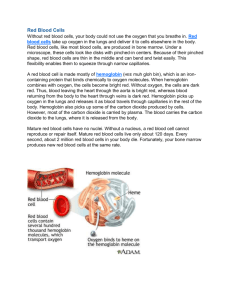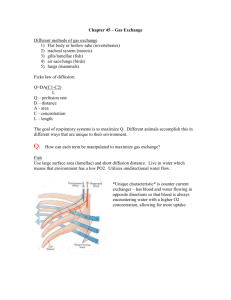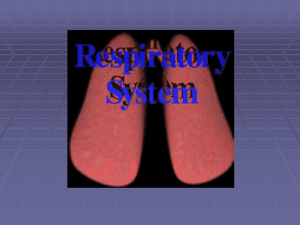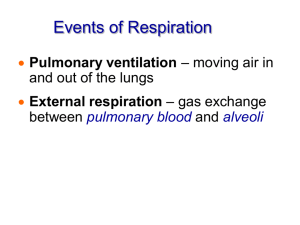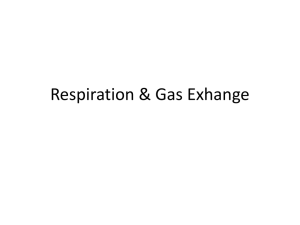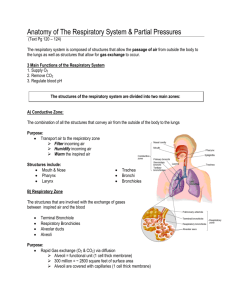Respiration
advertisement
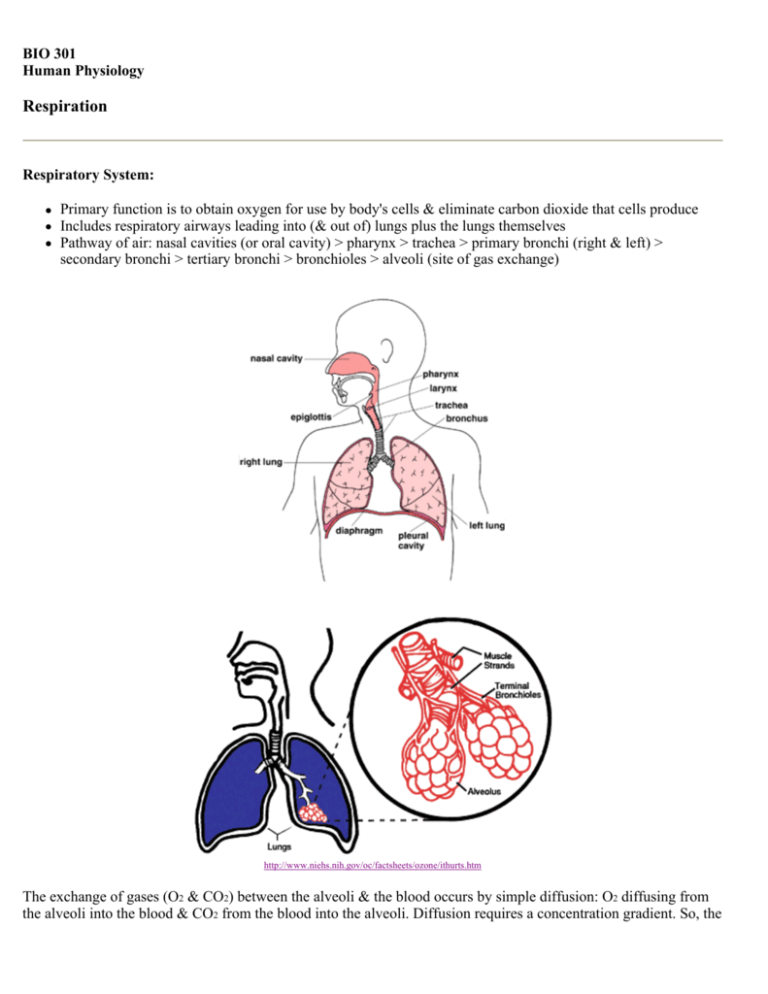
BIO 301
Human Physiology
Respiration
Respiratory System:
z
z
z
Primary function is to obtain oxygen for use by body's cells & eliminate carbon dioxide that cells produce
Includes respiratory airways leading into (& out of) lungs plus the lungs themselves
Pathway of air: nasal cavities (or oral cavity) > pharynx > trachea > primary bronchi (right & left) >
secondary bronchi > tertiary bronchi > bronchioles > alveoli (site of gas exchange)
http://www.niehs.nih.gov/oc/factsheets/ozone/ithurts.htm
The exchange of gases (O2 & CO2) between the alveoli & the blood occurs by simple diffusion: O2 diffusing from
the alveoli into the blood & CO2 from the blood into the alveoli. Diffusion requires a concentration gradient. So, the
concentration (or pressure) of O2 in the alveoli must be kept at a higher level than in the blood & the concentration
(or pressure) of CO2 in the alveoli must be kept at a lower lever than in the blood. We do this, of course, by
breathing - continuously bringing fresh air (with lots of O2 & little CO2) into the lungs & the alveoli.
Breathing is an active process - requiring the contraction of skeletal muscles. The primary muscles of respiration
include the external intercostal muscles (located between the ribs) and the diaphragm (a sheet of muscle located
between the thoracic & abdominal cavities).
The external intercostals plus the diaphragm contract to bring about inspiration:
z
z
Contraction of external intercostal muscles > elevation of ribs & sternum > increased front- to-back
dimension of thoracic cavity > lowers air pressure in lungs > air moves into lungs
Contraction of diaphragm > diaphragm moves downward > increases vertical dimension of thoracic cavity
> lowers air pressure in lungs > air moves into lungs:
http://www.fda.gov/fdac/features/1999/emphside.html
To exhale:
z
relaxation of external intercostal muscles & diaphragm > return of diaphragm, ribs, & sternum to resting
position > restores thoracic cavity to preinspiratory volume > increases pressure in lungs > air is exhaled
Intra-alveolar pressure during inspiration & expiration
As the external intercostals & diaphragm contract, the lungs expand. The expansion
of the lungs causes the pressure in the lungs (and alveoli) to become slightly
negative relative to atmospheric pressure. As a result, air moves from an area of
higher pressure (the air) to an area of lower pressure (our lungs & alveoli). During
expiration, the respiration muscles relax & lung volume descreases. This causes
pressure in the lungs (and alveoli) to become slight positive relative to atmospheric
pressure. As a result, air leaves the lungs.
The walls of alveoli are coated with a thin film of water & this creates a potential
problem. Water molecules, including those on the alveolar walls, are more attracted
to each other than to air, and this attraction creates a force called surface tension.
This surface tension increases as water molecules come closer together, which is
what happens when we exhale & our alveoli become smaller (like air leaving a
balloon). Potentially, surface tension could cause alveoli to collapse and, in addition,
would make it more difficult to 're-expand' the alveoli (when you inhaled). Both of
these would represent serious problems: if alveoli collapsed they'd contain no air &
no oxygen to diffuse into the blood &, if 're-expansion' was more difficult, inhalation would be very, very difficult
if not impossible. Fortunately, our alveoli do not collapse & inhalation is relatively easy because the lungs produce
a substance called surfactant that reduces surface tension.
Role of Pulmonary Surfactant
z
Surfactant decreases surface tension which:
{ increases pulmonary compliance (reducing the effort needed to expand the lungs)
{ reduces tendency for alveoli to collapse
Lung cells that produce surfactant
Exchange of gases:
z
External respiration:
exchange of O2 & CO2 between external environment & the cells of the body
efficient because alveoli and capillaries have very thin walls & are very abundant (your lungs have
about 300 million alveoli with a total surface area of about 75 square meters)
Internal respiration - intracellular use of O2 to make ATP
occurs by simple diffusion along partial pressure gradients
{
{
z
z
What is Partial Pressure?:
z
z
it's the individual pressure exerted independently by a particular gas within a mixture of gasses. The air we
breath is a mixture of gasses: primarily nitrogen, oxygen, & carbon dioxide. So, the air you blow into a
balloon creates pressure that causes the balloon to expand (& this pressure is generated as all the molecules of
nitrogen, oxygen, & carbon dioxide move about & collide with the walls of the balloon). However, the total
pressure generated by the air is due in part to nitrogen, in part to oxygen, & in part to carbon dioxide. That
part of the total pressure generated by oxygen is the 'partial pressure' of oxygen, while that generated by
carbon dioxide is the 'partial pressure' of carbon dioxide. A gas's partial pressure, therefore, is a measure of
how much of that gas is present (e.g., in the blood or alveoli).
the partial pressure exerted by each gas in a mixture equals the total pressure times the fractional composition
of the gas in the mixture. So, given that total atmospheric pressure (at sea level) is about 760 mm Hg and,
further, that air is about 21% oxygen, then the partial pressure of oxygen in the air is 0.21 times 760 mm Hg
or 160 mm Hg.
Partial Pressures of O2 and CO2 in the body (normal, resting conditions):
z
Alveoli
{ PO2 = 100 mm Hg
{ PCO2 = 40 mm Hg
z
Alveolar capillaries
{ Entering the alveolar capillaries
PO2 = 40 mm Hg (relatively low because this blood has just returned from the systemic
circulation & has lost much of its oxygen)
PCO2 = 45 mm Hg (relatively high because the blood returning from the systemic circulation has
picked up carbon dioxide)
While in the alveolar capillaries, the diffusion of gasses occurs: oxygen diffuses from the alveoli into the blood &
carbon dioxide from the blood into the alveoli.
{
Leaving the alveolar capillaries
PO2 = 100 mm Hg
PCO2 = 40 mm Hg
Blood leaving the alveolar capillaries returns to the left atrium & is pumped by the left ventricle into the systemic
circulation. This blood travels through arteries & arterioles and into the systemic, or body, capillaries. As blood
travels through arteries & arterioles, no gas exchange occurs.
{
{
Entering the systemic capillaries
PO2 = 100 mm Hg
PCO2 = 40 mm Hg
Body cells (resting conditions)
PO2 = 40 mm Hg
PCO2 = 45 mm Hg
Because of the differences in partial pressures of oxygen & carbon dioxide in the systemic capillaries & the body
cells, oxygen diffuses from the blood & into the cells, while carbon dioxide diffuses from the cells into the blood.
{
Leaving the systemic capillaries
PO2 = 40 mm Hg
PCO2 = 45 mm Hg
Blood leaving the systemic capillaries returns to the heart (right atrium) via venules & veins (and no gas exchange
occurs while blood is in venules & veins). This blood is then pumped to the lungs (and the alveolar capillaries) by
the right ventricle.
How are oxygen & carbon dioxide transported in the blood?
z
Oxygen is carried in blood:
1 - bound to hemoglobin (98.5% of all oxygen in the blood)
2 - dissolved in the plasma (1.5%)
Because almost all oxygen in the blood is transported by hemoglobin, the relationship between the concentration
(partial pressure) of oxygen and hemoglobin saturation (the % of hemoglobin molecules carrying oxygen) is an
important one.
Hemoglobin saturation:
z
z
extent to which the hemoglobin in blood is combined with O2
depends on PO2 of the blood:
The relationship between oxygen levels and hemoglobin saturation is indicated by the oxygen-hemoglobin
dissociation (saturation) curve (in the graph above). You can see that at high partial pressures of O2 (above about
40 mm Hg), hemoglobin saturation remains rather high (typically about 75 - 80%). This rather flat section of the
oxygen-hemoglobin dissociation curve is called the 'plateau.'
Recall that 40 mm Hg is the typical partial pressure of oxygen in the cells of the body. Examination of the oxygenhemoglobin dissociation curve reveals that, under resting conditions, only about 20 - 25% of hemoglobin molecules
give up oxygen in the systemic capillaries. This is significant (in other words, the 'plateau' is significant) because it
means that you have a substantial reserve of oxygen. In other words, if you become more active, & your cells need
more oxygen, the blood (hemoglobin molecules) has lots of oxygen to provide
When you do become more active, partial pressures of oxygen in your (active) cells may drop well below 40 mm
Hg. A look at the oxygen-hemoglobin dissociation curve reveals that as oxygen levels decline, hemoglobin
saturation also declines - and declines precipitously. This means that the blood (hemoglobin) 'unloads' lots of
oxygen to active cells - cells that, of course, need more oxygen.
Factors that affect the Oxygen-Hemoglobin Dissociation Curve:
The oxygen-hemoglobin dissociation curve 'shifts' under certain conditions. These factors can cause such a shift:
z
z
z
z
lower pH
increased temperature
more 2,3-diphosphoglycerate
increased levels of CO2
These factors change when tissues become more active. For example, when a skeletal muscle starts contracting, the
cells in that muscle use more oxygen, make more ATP, & produce more waste products (CO2). Making more ATP
means releasing more heat; so the temperature in active tissues increases. More CO2 translates into a lower pH. That
is so because this reaction occurs when CO2 is released:
CO2 + H20 -----> H2CO3 -----> HCO3- + H+
& more hydrogen ions = a lower (more acidic) pH. So, in active tissues, there are higher levels of CO2, a lower pH,
and higher temperatures. In addition, at lower PO2 levels, red blood cells increase production of a substance called
2,3-diphosphoglycerate. These changing conditions (more CO2, lower pH, higher temperature, & more 2,3diphosphoglycerate) in active tissues cause an alteration in the structure of hemoglobin, which, in turn, causes
hemoglobin to give up its oxygen. In other words, in active tissues, more hemoglobin molecules give up their
oxygen. Another way of saying this is that the oxygen-hemoglobin dissociation curve 'shifts to the right' (as shown
with the light blue curve in the graph below). This means that at a given partial pressure of oxygen, the percent
saturation for hemoglobin with be lower. For example, in the graph below, extrapolate up to the 'normal' curve
(green curve) from a PO2 of 40, then over, & the hemoglobin saturation is about 75%. Then, extrapolate up to the
'right-shifted' (light blue) curve from a PO2 of 40, then over, & the hemoglobin saturation is about 60%. So, a 'shift
to the right' in the oxygen-hemoglobin dissociation curve (shown above) means that more oxygen is being released
by hemoglobin - just what's needed by the cells in an active tissue!
Carbon dioxide - transported from the body cells back to the lungs as:
1 - bicarbonate (HCO3) - 60%
{ formed when CO2 (released by cells making ATP) combines with H2O (due to the enzyme in red blood
cells called carbonic anhydrase) as shown in the diagram below
2 - carbaminohemoglobin - 30%
{ formed when CO2 combines with hemoglobin (hemoglobin molecules that have given up their oxygen)
3 - dissolved in the plasma - 10%
Control of Respiration
Your respiratory rate changes. When active, for example, your respiratory rate goes up; when less active, or
sleeping, the rate goes down. Also, even though the respiratory muscles are voluntary, you can't consciously control
them when you're sleeping. So, how is respiratory rate altered & how is
respiration controlled when you're not consciously thinking about respiration?
The rhythmicity center of the medulla:
z
z
controls automatic breathing
consists of interacting neurons that fire either during inspiration (I neurons) or expiration (E neurons)
{ I neurons - stimulate neurons that innervate respiratory muscles (to bring about inspiration)
{ E neurons - inhibit I neurons (to 'shut down' the I neurons & bring about expiration)
Apneustic center (located in the pons) - stimulate I neurons (to promote inspiration)
Pneumotaxic center (also located in the pons) - inhibits apneustic center & inhibits inspiration
Factors involved in increasing respiratory rate
z
z
Chemoreceptors - located in aorta & carotid arteries (peripheral chemoreceptors) & in the medulla (central
chemoreceptors)
Chemoreceptors (stimulated more by increased CO2 levels than by decreased O2 levels) > stimulate
Rhythmicity Area > Result = increased rate of respiration
Heavy exercise ==> greatly increases respiratory rate
Mechanism?
z
z
z
NOT increased CO2
Possible factors:
{ reflexes originating from body movements (proprioceptors)
{ increase in body temperature
{ epinephrine release (during exercise)
impulses from the cerebral cortex (may simultaneously stimulate rhythmicity area & motor neurons)
Related links:
Gas Exchange I
Inspiration and Expiration
The Respiratory System
Respiratory System
Introduction to Anatomy: Respiratory System
The Human Respiratory System
Structure and Function of the Lung
Gas Exchange in Humans
Back to BIO 301 syllabus
Lecture Notes 1 - Cell Structure & Metabolism
Lecture Notes 2 - Neurons & the Nervous System I
Lecture Notes 2b - Neurons & the Nervous System II
Lecture Notes 3 - Muscle
Lecture Notes 4 - Blood & Body Defenses I
Lecture Notes 4b - Blood & Body Defenses II
Lecture Notes 5 - Cardiovascular System


